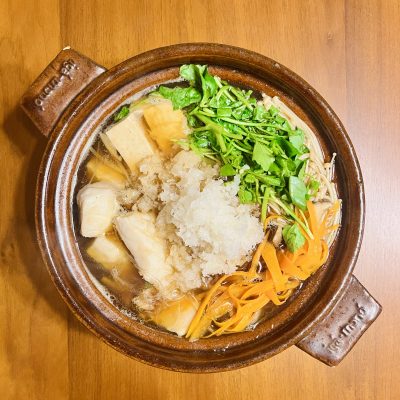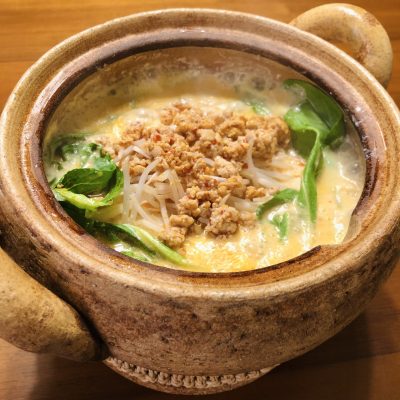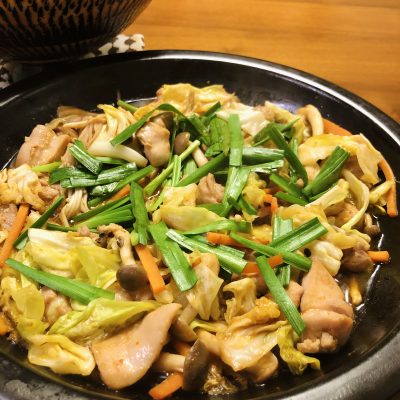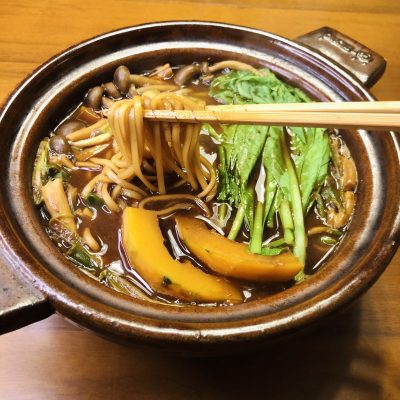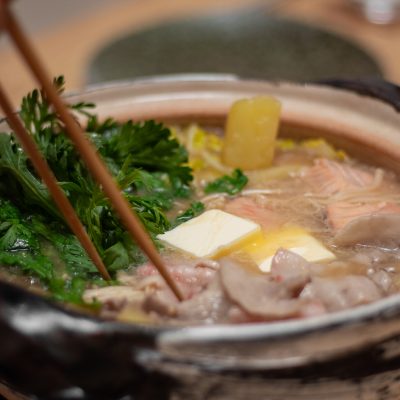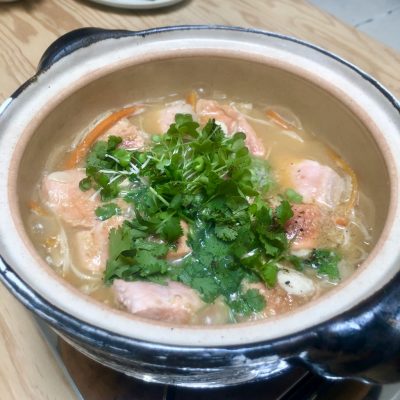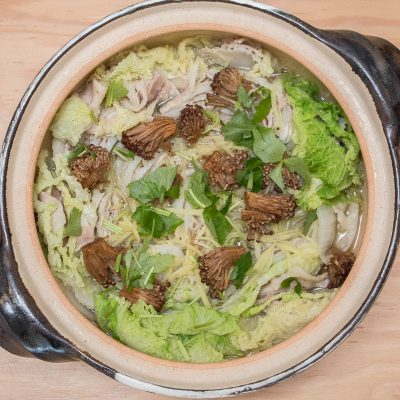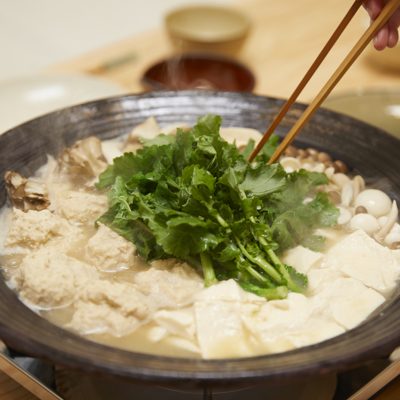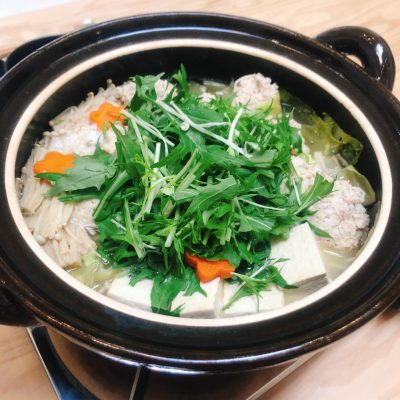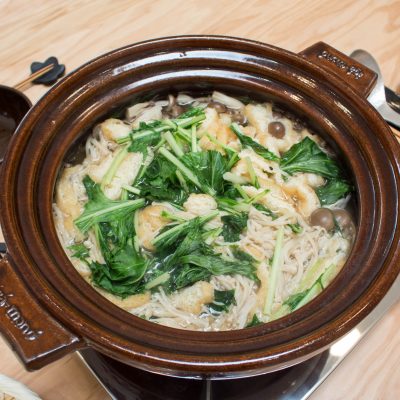Here’s my healthy seafood hot pot, Halibut Mizore Nabe – Halibut (or your choice of fish) is quickly simmered with vegetables and finished with a generous amount of grated daikon on top. With the addition of the glass noodles, this dish makes a very satisfying one pot donabe meal.
Tag Archives: Enoki
Soymilk Tan Tan Nabe
Tan Tan Nabe, or Chinese-inspired miso-sesame broth with ground meat donabe hot pot is one of the most popular dishes from my DONABE Cookbook. Here is another variation of Tan Tan Nabe and it’s Soymilk Tan Tan Nabe. The soymilk adds the extra richness to the flavor of this dish, while the dish is quite healthy. The broth is so flavorful and soothing with a spicy kick. Also, it’s so easy to make. So, I love making this dish so much.
Sizzling Shoyu Chicken & Cabbage
Kei-chan is a very popular local dish from Gifu, Japan. In my past visits to Gifu, I was really fascinated by this homy chicken dish. The main ingredients are chicken and cabbage, and they are sit-fried together in either miso or soy-based sauce. I especially love the soy-based version, so I now have my own version and it’s so good. Because it’s stir-fried, tagine-style donabe works especially great with its flat skillet bottom. But, you can also improvise the dish with other types of donabe which can be heated empty.
Hatcho Miso Udon Hot Pot
This dish can be made so quickly and create a balanced one-pot meal. I love the deep flavor of hatcho miso which is a dark miso. The flavor is almost chocolaty. Once the udon noodles are par-cooked, all the ingredients are cooked in one donabe. I like vegetables and tofu in this dish, so this dish is completely vegan. But, if you like, you can also enjoy this dish with an addition of meat. Chicken or duck slices are particularly good.
Miso Butter Hot Pot with Salmon and Pork
I’ve made this hot pot many times this season, both for myself and many other people. And, many of them asked me to share the recipe so they can make it home. The miso broth has two kinds of miso for complexity. The addition of butter at the end gives the beautiful depth in flavor.
Ishikari Nabe is originally a regional dish from Hokkaido (the northern island of Japan), and to me, the must “rule” to be called Ishikari Nabe is that the dish has to have salmon and potato in the miso broth. They taste so good together (especially with the butter added at the end)! That being said, the broth can go well with just about anything, so you can change around the ingredients to cook in it. When I cook for my vegan friends, I use kombu and shiitake dashi, and make it with tofu and different kinds of mushrooms (and no butter).
You can make the miso base (mixture of the miso, sake, mirin and soy sauce) in advance, and when it’s ready to serve, you can simply combine the miso base with dashi, and start cooking the ingredients in it at the table (or at in the kitchen stove and serve at the table).
For “shime” (finishing course), I love making ojiya (soupy porridge) in the remaining broth. Ramen is also great, too.
Salmon and Daikon in Garlic Butter Miso Sauce
Garlic, miso, and butter…they make a brilliant combination of flavors. The main ingredients to cook in the sauce are salmon (or you can use your choice of high quality rich flavor fish) and daikon, and they are piled up with a few other ingredients and quickly simmered in the sauce. The dish has a nice rich flavor with refreshing accent with the yuzu juice. I used cilantro and daikon sprouts as a garnish for this recipe, but dill is also a nice alternative.
Pork and Napa Cabbage Mille Feuille
This dish is all about pork and napa cabbage, cooked in a minimum way. They are simply layered to pack in a donabe, with a small amount of water and sake. There is not even dashi or salt. You can top them with some sliced ginger and mushrooms, and gently simmer for 25 – 30 minutes. The result is a tasty treat rich in umami, and it looks beautiful, too. The soup is also packed with all the natural flavors from the ingredients, so make sure to enjoy it with the dish, too.
I like to serve it with Sansho Ponzu Sauce and Hatcho Miso & Black Sesame Sauce (recipe below) for flavor variations. Or, you can simply serve it with yuzu-kosho or Kanzuri, too.
Tofu & Spinach Hot Pot
Yu-Dofu (tofu hot pot) is a very simple and popular home dish in Japan. This version has addition of spinach and enoki mushrooms to boost nutrients and flavors. Yu-Dofu‘s best accompaniment is ponzu, and my quick daidai citrus ponzu tastes so refreshing and aromatic. Then, you can top the tofu with a generous amount of freshly-ground toasted sesame seeds in suribachi and surikogi (Japanese mortar and pestle), which is so nutty and aromatic. Kanzuri (chili condiment from Niigata, Japan) is another great condiment.
Chicken Meatball Hot Pot in Miso Broth
This simple miso-flavored hot pot is always so popular among my family and friends. By adding grated ginger and egg, the chicken meatballs becomes so fluffy and flavorful. The other main ingredients are tofu and mushrooms, which complete the dish to full satisfaction. The suggested shime (finishing course) to cook in the saved broth is udon or ramen.
Egg Drop Vegetable Soup
This soup is full of flavors and very satisfying. The addition of the black vinegar gives the nice umami-rich accent to the dish. The fluffy egg with vegetables make wonderful layers of textures, too. I like to sprinkle some sansho powder to the soup for extra kick, but it’s totally optional.
Salt Butter Chanko Hot Pot
Japanese sumo wrestlers cook and eat chanko nabe at their stable every day. That’s the source of their strength. While chanko nabe refers to any types of hot pot eaten by sumo wrestlers, the most typical style is chicken as a main protein and cooked in chicken broth. It’s because chicken stands on two legs like human beings, so it is considered to bring good luck (in sumo, you lose if your hands touch the ground). Chanko nabe typically makes a very nutritious and balanced meal, as you cook a wide variety of healthy ingredients in one pot. The sumo wrestlers are big, because they eat so much of it every meal! In my version, I cook chicken meatballs and vegetables in simple salt-flavored chicken broth, and add butter cubes right before serving. The aroma is so irresistible and the flavor is superb. As a shime (finishing course), I suggest ramen noodles to cook in the remaining broth.
Mushroom & Mizuna Hot Pot
This simple vegan hot pot is so rich in flavor and satisfying. I like to slice the abura-age very thin, as these slices soak up the broth and taste like juicy noodles. If you don’t have access to abura-age, thinly-sliced tofu can work, too. The key for the rich broth flavor is to add the mushrooms before heating up the kombu-soaked water, so the mushrooms release all the umami flavors during the slow heating process. For the shime (finishing course), I like to add udon noodles to the remaining broth, but soba is also good, too.

